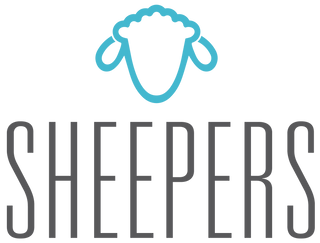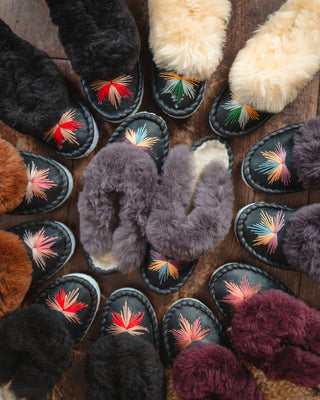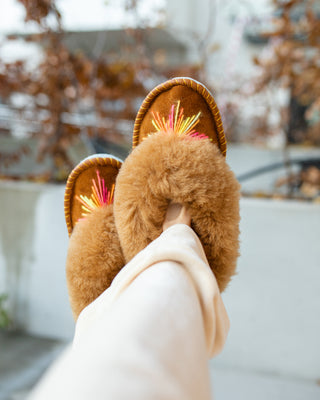Sheepskin is no doubt one of the most timeless, useful, and versatile materials on our beloved planet. It has graced our lives with warmth, comfort, and cosiness for many generations which is why it makes sense to understand some of sheepskin’s fundamentals and the sustainable practices around it.
In this piece, we discuss the basics of sheepskin, detailing how the ethical and eco-friendly practices impact both product quality and the environment.
What is sheepskin? Is it sustainable?
Sheepskin is derived from sheep’s wool and is something which has been cherished for hundreds of years due to its incredible versatility. From clothing and accessories to home furnishings, it has many different applications today, making people’s lives more comfortable in a number of ways.
However, not all sheepskin products are made from 100% genuine sheepskin, with many of them made in a non-sustainable way.
So, why then should be use sustainable sheepskin only?
Natural and authentic sheepskin is a renewable and sustainable resource. It is an environmentally-friendly alternative to traditional man-made materials used in different kinds of clothing and accessories, for example. So, by choosing natural 100% sheepskin, you are making an eco-friendly choice and going with a sustainable resource which will serve you well over many decades.
Our sheepskin, which is sourced from sheep receiving ethical treatment by way of a meticulous tanning process, helps not only in the welfare of sheep but also promotes the use of eco-friendly techniques in the tanning process. As a natural sheepskin product manufacturer, we are dedicated to upholding the highest sheepskin industry standards – an ongoing commitment which ensures that every step in the production process is fully aligned with the latest environmental and ethical best practices.
From day one, Sheepers has been on a quest to source only the most sustainable materials and innovative alternatives to traditional sheepskin products, providing buyers with only the most sustainable and eco-friendly options.
One major innovation as such is the use of natural dyes in all our sheepskin products – be it coats, slippers, rugs, or hot water bottle covers, for instance. The use of natural dyes allows us to reduce our environmental footprint in our production processes while also helping us in maintaining the highest ethical standards. By not using conventional chemical-based colouring, we are able to design products to the highest standards which exude unmatched quality while allowing consumers to enjoy and appreciate the timeless appeal of natural sheepskin.
If you’re someone who seeks both luxury and sustainability without breaking the bank, then our selection of products certainly has you covered!

What is the environmental impact of sheepskin?
The sheepskin we use in our range is a by-product of the meat industry. So this means that we use materials which would otherwise be treated as ‘waste’ and repurpose it as premium products which can both be worn as clothes, slippers, and accessories, or used tastefully as home décor items.
The offcuts we use in the making of many of our products, including hot water bottle covers, is waste from the manufacturing process of other products – such as sheepskin slippers and coats, for example. We gather the offcuts to be reused which means they never end up in a landfill. Owing to this ‘wasteless’ design, we are able to provide consumers with an ethical, eco-friendly, sustainable, and climate-friendly option, thus, contributing to a greener and more compassionate future.
This design philosophy and approach suits our environmentally-conscious consumers perfectly, where they find reassurance knowing that no harsh chemicals or dyes have been used in the production of each product, as well as where animals have been treated in a humane and ethical way.
Benefits of choosing sustainable sheepskin over traditional alternatives
Natural 100% sheepskin is a biodegradable and long-lasting material. It is highly durable, particularly when compared to synthetic sheepskin fibres which are widely produced today, both in the UK and across the world.
As many consumers are aware, man-made materials have a significantly shorter lifespan and end up in landfills for the most part, and very rapidly too. Since 100% genuine sheepskin is biodegradable, if it does need to be discarded, it doesn’t take up space in a landfill for many years, unlike synthetic sheepskin products, which can contribute significantly to a larger environmental footprint.
Natural sheepskin also requires a lot less energy to produce compared to synthetic materials. The latter are petroleum-based, so that means they tend to utilise up to three times more energy during the production process.
Production processes involving petroleum can lead to very harmful emissions as it is a non-renewable resource. In fact, as much as up to a gallon of petroleum is required to produce just three jackets or coats made of synthetic sheepskin. Plus, the production of items containing synthetic fibres involves several chemical reactions at very high temperatures, which can potentially produce many harmful substances.
Petroleum cannot be used at the rate it is still being used across multiple industries primarily because:
- It’s highly adverse effects on the environment, and;
- Fossil fuels being depleted completely within the next 40-60 years
At Sheepers, all our sheepskin products are tanned using a highly sustainable and environmentally-friendly method which not only improves quality and but also drastically cuts down environmental impact. We use the cleanest water possible in producing each one of our products and keep chemical content as low in our sheepskins as possible. Additionally, we are constantly testing each product for health and safety – not just for the end consumer but also for our internal team.
Finally, our sheepskin is sourced from free-roaming flocks which do not require any additional resources apart from those that are already being used to supply the meat industry (offcuts). The grass and plants these flocks graze on are the result of natural rainfall, which means carbon is drawn out of the atmosphere and converted to energy to grow the sheepskin.
From sheepskin slippers for men and women to children’s sleepwear, baby booties and luxurious sheepskin rugs, pet beds, blankets, and more – the highest quality standard, sustainability, and eco-friendliness are all at the heart of each product.









